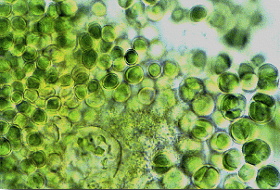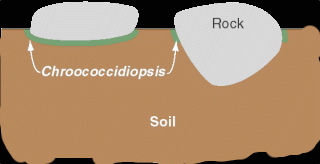Hardy Bacteria Thrive Under Hot Desert Rocks

Beneath the rocks scarring California's Mojave Desert are colonies of cyanobacteria, tiny creatures thought to be some of the first on Earth to convert light from the Sun into energy in the process known as photosynthesis. By studying how these creatures adapt to life in the hot, dry desert, biologists hope to glean insight into how microbial life of some sort might fare on Mars.
A recent study published last year in the International Journal of Astrobiology examined how these organisms survived when different types of rock stood between them and the Sun. It found that the dominant type, Chroococcidiopsis, thrived beneath a variety of geologic types, from quartz to talc.
"The versatility of Chroococcidiopsis in inhabiting dry niches with different light availability to support photosynthesis extends our appreciation of the limit of photosynthesis," biologist Daniela Billi of the University of Rome, told Astrobiology Magazine by email. [5 Bold Claims of Alien Life]
Billi worked with lead author and biologist Heather Smith of Utah State University to categorize the bacteria hiding beneath various rocks in the Mojave Desert in order to better understand the environments bacteria on Earth endure. The results forge a link between Chroococcidiopsis and potential life forms on past or present Mars.
Lights on, power up
Cyanobacteria, often called blue-green algae, were one of the first life forms to pop up on Earth about 3.5 billion years ago. These microscopic organisms dramatically changed Earth's atmosphere by producing enough oxygen to fuel the evolution of complex life forms and the biodiversity we see today. At that ancient time in Earth's history, Mars was also a different place and a far cry from its barran, frigid deserts of today. Scientists speculate that the Red Planet could have also been hospitable to life.
"On Mars, in the past 3.8 billion years, water existed in the liquid phase on the surface," planetary scientist Jean-Pierre Paul de Vera of the German Aerospace Center Institute of Planetary Research told Astrobiology Magazine by email. "At the time life on Earth started it is also possible that the first bacteria also originated in the lakes or oceans of Mars."
De Vera studies bacteria and lichens that thrive in challenging environments, and is working with Billi to study Chroococcidiopsis on the International Space Station as part of the Biology and Mars Experiment.
Get the Space.com Newsletter
Breaking space news, the latest updates on rocket launches, skywatching events and more!
If life on Earth and Mars evolved in similar ways at about the same time, cyanobacteria could help scientists better understand what to look for on the Red Planet, should there be remains to be found. [The Search for Life on Mars (A Photo Timeline)]
"Cyanobacteria might be a good reference system for searching for life on Mars, and we could expect similar remnants of membrane structures like these bacteria, although it is not clear if photosynthesis could have been invented also on Mars," de Vera said.
Billi worked with a team of scientists to study the effects of different rocks in the Mojave Desert on the photosynthesis process. Examining cyanobacteria beneath talc, marble, quartz, and red- and white-coated carbonate, they determined that the genus Chroococcidiopsis dominated the environment beneath each sample.

Chroococcidiopsis is one of the most primitive cyanobacteria, thriving in a wide range of extreme environments across Earth. In the past, it has been suggested as an organism that could help to change the Martian dirt into a more arable soil that humans could farm during long-term colonization.
"In dry areas, cyanobacteria of the genus Chroococcidiopsis are often dominant," Billi said.
One reason they thrive might have to do with how they respond to the different waves of light that pass through the edges of each rock. Rather than remaining stagnant, the cyanobacteria were able to change the types of light they required for photosynthesis based on what was available.

"Chroococcidiopsis displayed the capability to adapt to the different light availability by changing the spectroscopic features of the photosynthetic pigments," said Billi.
If similar cyanobacteria developed on Mars, it is possible that they, too, could have boasted the potential to thrive under the different types of rocks on the Red Planet.
The research was funded by the Italian Ministry of Foreign Affairs, Direzione Generale per la Promozione del Sistema Paese, NASA's Astrobiology Science and Technology for Exploring Planets (ASTEP), and the NASA Graduate Student Research Program. The BIOMEX research is supported by the European Space Agency and the German Aerospace Center/Federal Ministry of Economics and Energy.
The last survivors?
Cyanobacteria played an important role in the evolution of life on Earth. Originally, the bacteria were dubbed "blue-green algae," but the discovery of genetic material spread throughout their cell, rather than within the nucleus, helped scientists understand that the creatures are bacteria, not algae. The bacteria live in a variety of different regions, from oceans to hot springs to rocky locales like the Mojave, and are capable of living in both low- and high-oxygen environments.For scientists, cyanobacteria come in handy in determining how life persists in extreme conditions and might even endure on a place as seemingly inhospitable as Mars.
Although the harsh landscape photographed by Curiosity may appear similar to Earth's deserts, the two types of regions can also be very different. Mars is dry—drier than any of Earth's desert. The temperatures are colder, the atmospheric pressures lower, and the atmosphere so thin that intense radiation from the Sun pierces the surface.
"We can use cyanobacteria in Mars simulation experiments and test them under Mars-like conditions in specific simulation chambers," de Vera said.
"If they are able to grow, to be metabolically active, and also to photosynthesize during Mars simulation experiments, this could give very good indications that Mars was recently a habitable planet."
The huge temperature difference between the Martian night and day affects the humidity levels on Mars, because warm air can hold more water vapor than cold air. At night, the air is saturated with water vapor—reaching humidity levels of 100 percent—while during daylight hours, the humidity level is far lower.De Vera cited the work of Dirk Möhlmann, a physics professor at the Collegium Budapest who studies water on Mars and asks whether or not the planet could be habitable today. These conditions would depend on the ability of cyanobacteria to use the high humidity of Martian soil at night, as well as in the very early morning or evening when light might be available for photosynthesis. Cyanobacteria found in salt deposits in former lakes in the Chilean Atacama Desert, the driest non-polar desert on Earth, have the potential to use salty liquids similar to those found flowing down Martian slopes seasonally.
At some point, Mars lost its protective atmosphere and its water. Hardy cyanobacteria, or something similarly robust, could be the last survivors of a devolving ecosystem on Mars.
"The first such refuges were likely in ice-free areas, similar to those found in the Antarctic Dry Valleys," Billi said, referring to one of the most extreme cold deserts on Earth.
As Mars' water retreated from its surface, any potential lifeforms would have hunkered down beneath the regolith to escape the harsher environment.
According to Billi, studying the cyanobacteria in conditions on Earth that simulate those on Mars can help researchers to define and spot biosignatures on Mars that could indicate life. Such investigations could prove useful for future missions to Mars that will scout for signs of life.
For now, however, it's a step in the right direction to know that our earthly cyanobacteria can thrive and adapt to living beneath Martian rocks of various types, be they quartz or shale.
This story was provided by Astrobiology Magazine, a web-based publication sponsored by the NASA astrobiology program. Follow Space.com @Spacedotcom, Facebook and Google+.
Join our Space Forums to keep talking space on the latest missions, night sky and more! And if you have a news tip, correction or comment, let us know at: community@space.com.

Nola Taylor Tillman is a contributing writer for Space.com. She loves all things space and astronomy-related, and enjoys the opportunity to learn more. She has a Bachelor’s degree in English and Astrophysics from Agnes Scott college and served as an intern at Sky & Telescope magazine. In her free time, she homeschools her four children. Follow her on Twitter at @NolaTRedd










